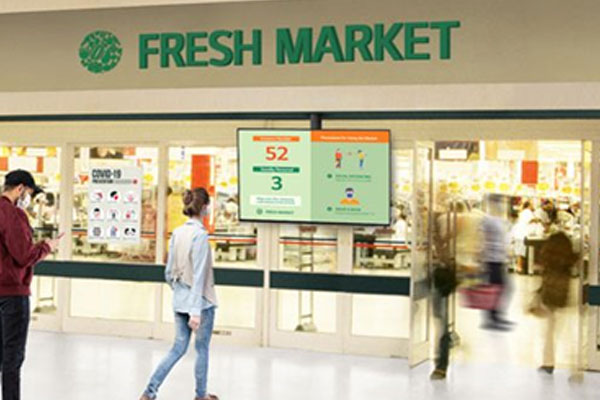
Reopening buildings safely, with LEED guidance, and tools and analytics from Arc
The US Green Building Council (USGBC) and affiliate Arc released LEED credits and software tools in recent weeks to help buildings reopen safely and sustainably from the coronavirus disease 2019 (COVID-19) pandemic shutdowns, and continue to operate safely in the long term.
Safety First LEED Pilot Credits
USGBC released four new Safety First LEED Pilot Credits in response to COVID-19 to support environmental and occupant health. The credits outline sustainable best practices that align with public health and industry guidelines related to cleaning and disinfecting, workplace reoccupancy, HVAC (heating, ventilation and air-conditioning) and plumbing operations. The credits can be used by LEED projects that are certified or are undergoing certification.
The Safety First credits are part of USGBC’s economic recovery strategy released last month, which focuses on sustainable solutions to rebuild a stronger and healthier economy by prioritizing “healthy people in healthy places.” The credits were created in direct response to COVID-19 and focus on the safety of those working in a building. These credits are available to all LEED 2009, LEED v4 and LEED v4.1 projects.
The Safety First: Cleaning and Disinfecting Your Space credit requires facilities to create a policy and implement procedures that follow green cleaning best practices that support a healthy indoor environment and worker safety. Unlike the need to develop new vaccines and medical treatments for COVID-19, current disinfectants and cleaning processes are effective against the SARS-CoV-2 virus that causes COVID-19, and sustainable options exist. In addition to product considerations, the credit also requires procedures and training for cleaning personnel, occupant education, and other services that are within a management team’s control.
The Safety First: Re-Enter Your Workspace credit is a tool to assess and plan for building reentry, as well as measure progress once a space is occupied. It identifies sustainable requirements in building operations and human behavior that take precautions against the spread of COVID-19. It aligns with the American Institute of Architects (AIA) Re-occupancy Assessment Tool and requires transparent reporting and evaluation of decisions to encourage continuous improvement.
The Safety First: Building Water System Recommissioning credit helps building teams reduce the risk that occupants are exposed to degraded water quality. Building and business closures over weeks or months reduce water usage that can potentially lead to stagnant water and water that is unsafe to drink or use. The credit integrates recommendations from industry organizations and experts, including the US EPA and CDC. It requires buildings to develop and implement a water management plan, coordinate with local water and public health authorities, communicate water system activities and associated risks to building occupants and take steps to address water quality from the community supply, as well as the building.
The Safety First: Managing Indoor Air Quality During COVID-19 credit builds on existing indoor air quality (IAQ) requirements and credits in LEED. Building teams should ensure IAQ systems are operating as designed and determine temporary adjustments to ventilation that may minimize the spread of COVID-19 through the air. Additional considerations include increasing ventilation and air filtration, physical distancing of occupants, and following measures outlined in public health and industry resources, as well as guidance found in the Re-Enter Your Workspace credit. The guidance also encourages monitoring and evaluating of indoor air quality on an ongoing basis.
These credits are based on current, known information. USGBC says it will refine its recommendations and is looking for feedback on the new credits.
In addition to these new LEED pilot credits, projects can also take advantage of Arc Re-entry, a set of resources (described below) to help facility teams assess and communicate recovery efforts, as well as the WELL Health-Safety Rating. GBCI will be providing third-party certification support for the WELL Health-Safety Rating.
With much of the country entering into an initial reopening phase, businesses and government must rebuild people’s trust and demonstrate how the estimated 5.6 million commercial buildings in the US are focused on health and committed to positively impacting communities moving forward, says USGBC. Third-party verification systems like LEED provide guidance on best practices and encourage transparency. USGBC is focused on sharing its recommendations with all projects, regardless of whether they are pursuing LEED certification, in an effort to continue to support economic recovery while also laying the foundation for society to be more sustainable, healthy and equitable.
LEED, or Leadership in Energy and Environmental Design, is a green building rating system for designing, constructing and operating sustainable buildings and spaces that promotes the use of strategies to reduce environmental impact, enhance human health and support economic development. Currently, there are over 102,000 projects across nearly 180 countries and territories participating, according to USGBC.
Arc Re-Entry tools and analytics
Arc, an affiliate of USGBC, launched Arc Re-Entry to support safe, confident workplace reentry in the wake of COVID-19 shutdowns. The new offering provides a set of tools and analytics designed to assist companies with reentering their buildings and facilities.
Arc is a technology platform that allows teams overseeing the sustainability of buildings and places to collect data, manage and benchmark progress, measure impact and improve performance. Arc empowers its users to understand and enhance their sustainability performance, promote human health and well-being and contribute to a higher quality of life.
Arc Re-Entry is a set of tools that can be used to document and benchmark infection-control policies and procedures, collect and analyze related occupant experiences, and measure and track indoor air quality around factors such as carbon dioxide, relative humidity and particulate matter.
Facilities managers (FMs) can use Arc Re-Entry to add data and generate a performance score for their building or portfolio that provides a comparable measure of the breadth and documentation of FM policies, occupant experience and measured IAQ. Arc Re-Entry allows FMs to evaluate the relationship between expectations for policies and procedures and occupants’ experience. It also helps identify opportunities to implement LEED’s Safety First Credits and the WELL Health-Safety Rating.


